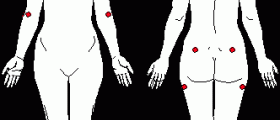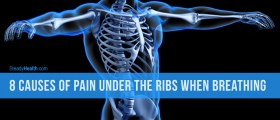Muscle fatigue is a quite common condition and can be experienced by everybody. This type of fatigue occurs anytime the muscles cannot exert normal force, or when more effort than normal is required to achieve a desired level of force.
Muscle pain is a normal response to unusual exertion and is part of an adaptation route that leads to better stamina and strength as the muscles recover and build hypertrophy. Muscle hypertrophy is the growth and increase of the size of muscle cells, and it usually occurs as a result of physical exercise such as weight lifting.

Causes of Muscle Fatigue
Muscular fatigue may occur for a number of different reasons. Sometimes, the reasons behind muscle fatigue are completely genetic, while it remains self-induced in the great majority of cases.
The most common reason behind muscle fatigue is physical exercise, and it usually occurs as a delayed reaction, appearing 12-48 hours after the exercise. This type of muscle pain is the most common at the beginning of a new exercise program or after a considerable increase in the intensity of the exercise. This kind of pain is worse within the first 2 days following the activity and then diminishes over the next couple of days.
Anemia is another common cause of muscle fatigue. The pain in the muscles occurs when there is not enough oxygen supplied to the muscle cells. Consequently, the muscles cannot function at their optimum and the patient develops symptoms of muscular fatigue.
Certain medications are also associated with muscular fatigue. The pain in the muscles appears as a side effect. Both prescribed and over-the-counter medications may cause muscular fatigue, but this happens only in a small number of cases.
- There are many different fatigue classification methods. According to its duration, fatigue can be classified into acute fatigue and chronic fatigue. Acute fatigue can be quickly relieved by rest or life-style changes, whereas chronic fatigue is a condition defined as a persistent tiredness lasting>months that is not ameliorated by rest. Fatigue can also be classified as mental fatigue, which refers to the cognitive or perceptual aspects of fatigue, and physical fatigue, which refers to the performance of the motor system.
- The production of skeletal muscle force depends on contractile mechanisms, and failure at any of the sites upstream of the cross-bridges can contribute to the development of muscle fatigue, including nervous, ion, vascular and energy systems. Specifically, metabolic factors and fatigue reactants during the process of contraction, such as hydrogen (H+) ions, lactate, inorganic phosphate (Pi), reactive oxygen species (ROS), heat shock protein (HSP) and orosomucoid (ORM), also affect muscle fatigue.
- Central neurotransmitters, especially 5-HT, DA and NA, play important role during whole-body exercise and fatigue. 5-HT produces a negative effect, whereas methylphenidate, a DA-releasing enhancer and reuptake inhibitor, produces a positive effect in exercise performance.
- Blood flow can bring oxygen necessary for aerobic ATP production and remove by-products of metabolic processes in working muscles, thus playing an important role in the maintenance of force output. Muscle voluntary contractions increase the mean arterial blood pressure, which consequently decreases the net blood flow to the working muscle and induces fatigue.
- Muscular work must be supported by a ready supply of ATP energy. There are three major ATPases that require ATP for muscle activity: Na+/K+-ATPase, myosin ATPase and Ca2+ ATPase. The Na+/K+-ATPase pumps Na+ back out and K+ back into the fiber after an action potential. The myosin ATPase uses ATP to generate force and do work, and the Ca2+ ATPase pumps Ca2+ back into the SR, thus allowing for muscle relaxation. The activities of these enzymes account for 10%, 60% and 30% of total ATP use, respectively.
- Muscle contractions activate ATPases and promote glycolysis, thus leading to an increase in intracellular metabolites, such as H+, lactate, Pi and ROS, which contribute to the changes in cross-bridge activity.
- Organisms have different levels of adaptive responses to fatigue stress, including the CNS nervous system, sympathetic nervous system, endocrine system (hypothalamus-pituitary-adrenal axis, HPA axis), and innate immune system (that is, non-specific cytokines, complement system and natural killer cells). Many fatigue reactants, such as cortisol, catecholamine, IL-6 and HSPs, may have roles in muscle function.
Any kind of thyroid disease is tightly associated with weakness and fatigue. Both low and high thyroid levels are associated with muscular pain and weakness, among many other symptoms such as lethargy, memory problems, intolerance to cold or heat, etc.
Other known causes involve stress, diabetes, and various heart diseases.
Treatment for Muscle Fatigue
The first step to successful treatment is to find out what kind of condition or activity causes muscular pain. If fatigue results from physical exercise, the patient should consider a change in the exercise program and make sure he or she gets enough rest and relaxation during the day. A gentle massage may also help to relieve the symptoms.
If any other medical condition causes muscular fatigue, the patient should get involved in a controlled treatment and cure the underlying problem. A good nutritional supplement and a proper diet are recommended for any treatment during muscle fatigue.

















Your thoughts on this
Loading...